
may 2005
| Africa News : mining of the mineral coltan, which is used to make pinhead capacitors in mobile phones |
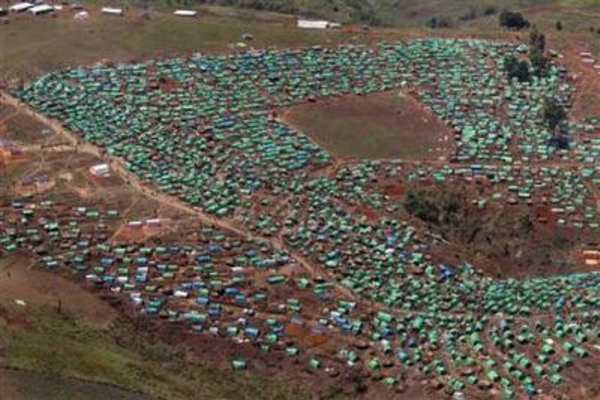
displacement camp
Congo, Democratic
Republic: Cell phones, forest destruction and death
Could anyone imagine that cell phones are tainted with
the blood of 3.2 million deaths since 1998? Also, that
the same thing happens with some children's video games?
And that mega-technologies contribute to forest
depredation and spoliation of the rich natural resources
of paradoxically impoverished peoples?
In the case of these new high techs, it is Coltan that is
at stake --the minerals columbium and 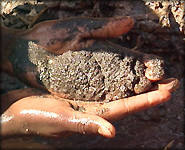 tantalite, or
Coltan for short. Tantalite is a rare, hard and dense
metal, very resistant to corrosion and high temperatures
and is an excellent electricity and heat conductor. It is
used in the microchips of cell phone batteries to prolong
duration of the charge, making this business flourish.
Provisions for 2004 foresee sales of 1,000 million units.
To these properties are added that its extraction does
not entail heavy costs --it is obtained by digging in the
mud-- and that it is easily sold, enabling the
tantalite, or
Coltan for short. Tantalite is a rare, hard and dense
metal, very resistant to corrosion and high temperatures
and is an excellent electricity and heat conductor. It is
used in the microchips of cell phone batteries to prolong
duration of the charge, making this business flourish.
Provisions for 2004 foresee sales of 1,000 million units.
To these properties are added that its extraction does
not entail heavy costs --it is obtained by digging in the
mud-- and that it is easily sold, enabling the
companies involved in the business to obtain juicy
dividends.
Even though Coltan is extracted in Brazil, Thailand and
much of it from Australia --the prime producer of Coltan
on a world level-- it is in Africa where 80% of the world
reserves are to be found. Within this continent, the
Democratic Republic of Congo concentrates over 80% of the
deposits, where 10,000 miners toil daily in the province
of Kivu (eastern Congo), a territory that has been
occupied since 1998 by the armies of Rwanda and Uganda. A
series of companies has been set up in the zone,
associated to large transnational capital, local
governments and military forces (both state and
"guerrilla") in a dispute over the control of
the region for the extraction of Coltan and other
minerals. The United Nations has not hesitated to state
that this strategic mineral is funding a war that the
former United States Secretary of State, Madeleine
Albright called "the first African world war"
(and we understand by world wars, those in which the
great powers share out the world), and ! is one of its
causes.
In August 1998, the Congolese Union for Democracy
(Rassemblement Congolais pour la Démocratie-RCD),
launched a rebellion in the city of Goma, supported by
the Rwanda Patriotic Army (RPA). Since then, in a
struggle in which, behind the myth of ethnic rivalries,
are hidden the old colonial powers that continue to
ransack the wealth of post-Colonial Africa, the war has
been rife between two, loosely defined parties. On the
one hand the RDC and the Governments of Rwanda and
Uganda, supported by the United States, relying on the
military bases such as that built in Rwanda by the United
States company Brown & Root, a branch of Halliburton,
where Rwandese forces are trained and logistic support is
provided to their troops in the DRC, together with United
States combat helicopters and spy satellites. The other
party is made up of the Democratic Republic of Congo (led
by one of Kabila's sons, after his father was
assassinated by the Rwandese), Angola, Namibia and
Zimbabwe.
However, behind these states are the companies sharing
out the zone. Various joint companies 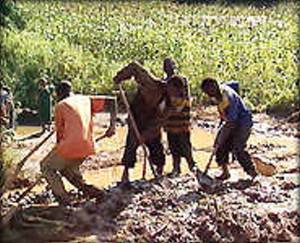 have been set up
for this purpose, the most important one being SOMIGL
(the Great Lakes Mining Company), a joint company set up
in November 2000, involving Africom, Premeco, Cogecom and
Cogear, (the latter two are Belgium companies --it should
be remembered that DRC, formerly the Belgium Congo, was a
Belgium colony), Masingiro GmbH (a German company) and
various other companies that ceased their activities in
January 2002 for various reasons (a drop in Coltan
prices, difficult working conditions, suspension of
Coltan imports from DRC) and are waiting for better
conditions: Sogem (a Belgian company), Cabot and Kemet
(U.S.) the joint United States-German company Eagles
Wings Resources (now with headquarters in Rwanda), among
others.
have been set up
for this purpose, the most important one being SOMIGL
(the Great Lakes Mining Company), a joint company set up
in November 2000, involving Africom, Premeco, Cogecom and
Cogear, (the latter two are Belgium companies --it should
be remembered that DRC, formerly the Belgium Congo, was a
Belgium colony), Masingiro GmbH (a German company) and
various other companies that ceased their activities in
January 2002 for various reasons (a drop in Coltan
prices, difficult working conditions, suspension of
Coltan imports from DRC) and are waiting for better
conditions: Sogem (a Belgian company), Cabot and Kemet
(U.S.) the joint United States-German company Eagles
Wings Resources (now with headquarters in Rwanda), among
others.
The transport companies belong to close family members of
the presidents of Rwanda and Uganda. In these virtually
military zones, private air companies bring in arms and
take out minerals. Most of the Coltan extracted is later
refined by a small number of companies in Germany, the
United States, Kazakhstan and the Far East. The branch of
Bayer, Starck produces 50% of powdered tantalite on a
world level. Dozens of companies are linked to the
traffic and elaboration of this product, with
participation of the major monopolizing companies in
Belgium, Germany, the Netherlands, Switzerland, and the
United States. As if this were not enough, the Trade,
Development and Industry Bank, created in 1996 with
headquarters in the capital city of Rwanda, Kigali, acts
as correspondent for the CITIBANK in the zone, and
handles large amounts of money from Coltan, gold and
diamond operations. Thirty-four companies import Coltan
from the Congo,
among these, 27 are of western origin, mainly Belgium,
Dutch and German.
The Belgium air company, Sabena is one of the means of
transporting the mineral from Kigali (capital city of
Rwanda) to Brussels, and associated to American Airlines,
announced last 15 June the suspension of the service,
under strong pressure from the world campaign "No
blood on my cell phone!" (or: "Pas de sang sur
mon GSM"), exhorting people not to buy cell phones
containing Coltan due to its repercussion on the
prolongation of the civil war in the Congo. As a result
of this campaign, the Belgium research institute
International Peace Information Service (IPIS) produced a
document in January 2002 "Supporting the War Economy
in the DRC: European Companies and the Coltan
Trade," which documents the leading role played by
the companies in promoting the war through their
cooperation with the military and exhorting that the
international consideration of the Coltan trade be given
priority over its local aspects.
The main zones where Coltan is extracted are located in
forest zones, such as the Ituri forest (see WRM bulletin
No. 67). The entry of military commandos and workers
(many of them farmers who have been dispossessed of their
lands and resources, seeking the promise of better
income), the installation of mining camps, the
construction of routes to reach and take out the coveted
mineral, all this goes to conspire against the forest as
a whole. Formerly fulfilling functions for the region and
the neighbouring peoples, the forest, once the
traditional lands of the hunting and gathering indigenous
peoples, such as the Mbuti and a reserve for gorillas and
okapis --a relative of the giraffe-- the habitat of
elephants and monkeys, has become the scenario for war
and depredation.
The African journalist, Kofi Akosah-Sarpong has even
stated that "Coltan in general terms is not helping
the local people. In fact, it is the curse of the
Congo." He has revealed that there is evidence that
this material contaminates, pointing out its connection
with congenital deformations in babies in the mining
zone, which are born with deformed legs.
Far from clean and innocent, these technologies, on which
the concentration of capitals is based and built, have
acquired through their "globalisation" their
highest expression, contaminating and breaking up the web
of life in its multiple and rich manifestations. In the
meanwhile, over the tombs of the 2000 African children
and farmers who die every day in the Congo, can we
absentmindedly continue to use our cell phones?
Article based on information from: "Supporting the
War Economy in the DRC: European Companies and the Coltan
Trade" and "European companies and the Coltan
Trade: an Update", International Peace Information
Service, http://users.skynet.be/ipis/tnewpubsnl.htm ;
"Basta de matanzas y saqueo en el Congo",
Solidarité Europe-Afrique, Belgium, http://www2.minorisa.es/inshuti/extracto.htm ;
"La fiebre del coltan: el imperialismo
continúa", Ramiro de Altube, Observatorio de
Conflictos, correo electrónico: obserflictos@yahoo.com.ar ,
http://www.nodo50.org/observatorio/coltan.htm ;
"La fiebre del coltan", Ramón Lobo, El País
Spain, 2/09/2001,
http://www.elpais.es/suplementos/domingo/20010902/1fiebre.html;
"UN report accuses Western companies of looting
Congo", Chris Talbot, 26/10/2002,(see below)
http://www.wsws.org/articles/2002/oct2002/cong-o26.shtml ;
"The Trouble With Coltan", Kofi Akosah-Sarpong,
http://www.expotimes.net/issue020116/AAbusiness2.htm
Source: WRM's bulletin Nº 69, April 2003
From: The Talking Drum Collective Newsletter <the_black_thought@yahoo.com>
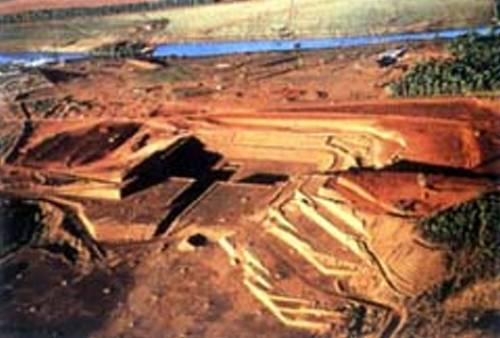
UPDATED NEWS APRIL 2005
Saturday 02 April 2005, 23:44 Makka Time, 20:44 GMT
United Nations troops killed up to 38 militia fighters during a raid by hundreds of peacekeepers backed by helicopter gunships in the Ituri district of eastern Congo, a UN military source has said. "It was serious fighting and 38 militiamen were killed," the source told Reuters. The clash came a day after a UN deadline expired for voluntary disarmament by militias, who have killed hundreds of civilians in the mineral-rich region. Earlier, the UN mission said South African, Bangladeshi and Pakistani peacekeepers exchanged fire with armed men as they searched two militia camps 40 km southwest of Bunia, capital of Ituri. The United Nations now has 16,700 soldiers in Congo, making it the largest peacekeeping mission in the world.
"The voluntary disarmament process is over," said UN spokeswoman Rachel Eklou. She said 8200 militia members had officially disarmed, while a few hundred more had also handed in their guns but had not yet been registered.Some fighters have said they will not join the disarmament process and Eklou said they would have to face the consequences. "We will make their lives more difficult - they will be prosecuted or face more military operations," she said. World's worst disaster The United Nations says eastern Congo is the world's worst humanitarian disaster. This week, aid workers reported a cholera outbreak in three camps set up for fleeing civilians.(We might ask why are civilians fleeing if disarmament is complete?JB.ed)
UN report accuses Western companies of looting Congo
By Chris Talbot
26 October 2002
An investigation carried out by a team of experts on behalf of the United Nations shows how the four year old war in the Congo has enabled the large-scale and systematic robbery of the country’s mineral wealth.
Rival groups of local politicians, military leaders and criminal elements are engaged in mining operations that use forced labour, child soldiers as well as indiscriminate killing and brutalising of the local populations that is reminiscent of the colonial rule of King Leopold of Belgium a century ago. None of the looting operations could be carried out without the collaboration and financial backing of Western companies that deal in rare metals, gems and other resources.
The report gives details of the activities carried out in the Democratic Republic of Congo (DRC), including some in conjunction with its military backers from Zimbabwe, as well as by the various groups acting in Congo with military support either from Rwanda or Uganda. Whilst the latter countries entered the war as allies, the report explains how they fought each other over diamond mining, with the key city of Kisangani ending up under Rwandan control.
Although only a few examples are given
of how billions of dollars from the illegal sale of
diamonds, gold, coltan (columbite-tantalite—the rare
mineral used in the manufacture of mobile phones,
laptops, which can fetch as much as $400 a kilogram),
cobalt, etc. end up in the accounts of Western
multinationals, the report lists 85 companies based in
the United States, Europe and South Africa that are said
to be breaking OECD “ethical guidelines.” They
include names such as Anglo American, Barclays Bank and
De Beers from Britain, Bayer A.G. from Germany and
America Mineral Fields and Cabot Corporation from the US.
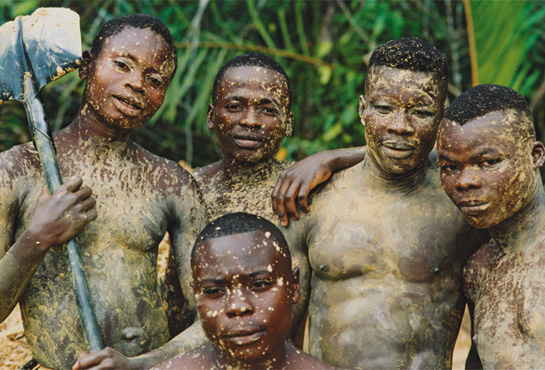
One of the key businessmen in DRC mining is the Belgian George Forrest. He is said to have “strong backing from some political quarters in Belgium,” although he was accused in a Belgian diplomatic cable seen by the investigators of running a “strategy of attrition” in the mining sector. Forrest operates in partnership with the US based OM Group and is said to run “one of the most profitable mining operations” in the DRC, which provides “the most marginal benefit” for the state mining corporation. It has access to a copper and cobalt stockpile in the Katanga region containing over 3,000 tons of the rare metal germanium, widely used in the electronics industry, and said to be worth more than $2 billion.
Bribing local officials to obtain mining licences and export permits is a normal procedure in gaining access to mineral exploitation. The UN investigators state that they have “extensive documentation” showing how First Quantum Minerals of Canada offered a down payment of $100 million to the DRC government to gain access to mineral concessions, as well as “cash payments and shares held in trust” to government ministers and officials, including the national security minister, the director of the National Intelligence Agency and the director of the state mining company.
Zimbabwean businessman John Bredenkamp is another key operator in the DRC, said by the report to be “experienced in setting up clandestine companies and sanctions-busing operations.” He has investments in a company said to “represent British Aerospace, Dornier of France and Augusta of Italy in Africa,” as well as controlling another company that supplies logistics to the Zimbabwean army.
Examples are given in the report of “commercial chains” linking the looting of minerals by local officials and soldiers with Western companies. A joint venture between the DRC government and the Zimbabwean military elite called Minerals Business Company (MBC) is said to use Zimbabwe’s influence to avoid paying licensing fees. MBC sells diamonds to the US firm Flashes of Color, the Swiss-based Ibryn & Associates, and Belgian-based companies Abadiam, Jewel Impex, Komal Gems and Diagem.
Another commercial chain relates to coltan from the Rwandan controlled eastern region of the Congo. A local concessionary, Eagle Wings Resources International, is a subsidiary of Trinitech International Inc. of the US . Eagle Wings is said not to “fulfil its full responsibilities to the public treasury” in the locality and to collaborate with the Rwandan army to “receive privileged access to coltan sites and captive labour.”
Some of the proceeds from Eagle Wings are sold to H.C. Starck, a subsidiary of the German transnational Bayer AG. Starck has repeatedly denied obtaining coltan from the Congo, but the UN team showed that consignments were routed through a company in Mozambique which provided false documents, then via South Africa to H.C.Starck in Thailand. A report from a key processing facility, Ningxia Non-Ferrous Metals Smeltery of China, seen by the UN investigators notes that 50 percent of the coltan it purchases originates in Central Africa—i.e. primarily from mining under control of the “Congo desk” of the Rwandan army that pay no taxes and use what the UN report describes as “a variety of forced labour regimes.” There is said to be widespread use of prisoners brought into the Congo from Rwanda as indentured labour.
The war’s impact
As well as providing much new information on the scramble for the Congo’s resources, the UN report gives some idea of the impact of the war on the population. It points out that the previous estimate for deaths due to the war, either directly through military attacks or indirectly through disease and malnutrition in the five eastern provinces of the Congo, was 2.5 million. That figure was for the period from August 1998 to April 2001. Assuming, as is likely, that the horrific conditions in the region have continued that would mean in excess of 3.5 million deaths today. The report suggests that in areas affected by the conflict the mortality rate for children under five years is as high as 35 percent.
In the areas occupied by Rwanda the UN
has already estimated that 1.5 million people were
displaced in March 2001. The present report explains how
the Rwandan army, as well as the Rwandan-backed rebels,
seize food and property from local inhabitants. Public
infrastructure has been devastated and the Secretary
General of the DRC in Goma requisitioned all revenue
generated by public utilities and parastatals. Water
purification for Kisangani and Bukavu stopped through
lack of chemicals and power stations closed through lack
of repair. The Catholic Church has protested
“thefts, torture, extortions, rapes and piracy on
Lake Tanganyika,” carried out by the military.
NGO’s have reported groups of women being taken
hostage and subject to sexual abuse, as well as children
being forced to work in the mines and conscripted into
the armies.
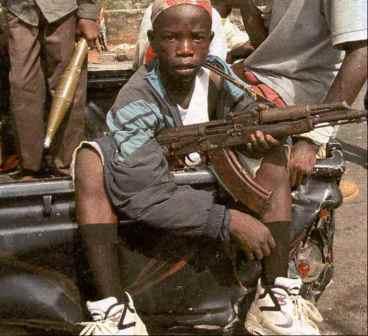
A similar catalogue of horrors is reported in the Ugandan occupied areas. The Ugandan army has trained the militia of a tribal group, the Hema, creating widespread conflict with another tribal grouping, the Lendu, who have also armed themselves. The UN report local young men all joining militias with no alternative source of food or medicine. “Children are killed, adult victims are eviscerated, women are raped, property stolen, houses burnt, churches demolished and whatever infrastructure exists is laid waste.”
A collapse of already limited public services is also reported in the DRC-Zimbabwe controlled areas. In Kasai Oriental four out of five water production plants don’t function and the fifth, in the diamond centre of Mbuji Mayi, runs at 20 percent capacity. A similar position holds in Kasai Occidental. The report states this is due to the diversion of state funds, often through fraud. Taxes have increased, allegedly to pay for the war, yet soldiers are largely unpaid and live by thieving and pillaging from the local population. In the South Katanga area deaths are increasing from malaria and dysentery. Medical facilities are non-existent and medical professionals are unpaid. The impact is acute on children, with 12 percent of all children under five dying each year.
Much of the UN report is given over to detailing the “elite networks” operating in the three areas controlled by the DRC government and Zimbabwe, Rwanda and Uganda respectively. In each case a small number of politicians, administrators, and military leaders “monopolise production, commerce and fiscal functions” and maintain their activities “through control of the military or other security forces that they use to intimidate, threaten violence or carry out selected acts of violence.” Air transport, arms deals and other transactions are carried out through “organised or transnational criminal groups.”
Although supposedly carried out with a view to imposing an end to the war in the Congo with an agreement backed by the US and other Western governments, the UN investigation exposes the sham nature of a peace process that has dragged on now for more than two years.
Under Western pressure Zimbabwe, Rwanda and Uganda are withdrawing at least some of their forces. Uganda has trained local militia to replace the official army. “There will be little change in the control that Ugandans exercise over trade flows and economic resources”, states the report. Rwanda has replaced local officials with Rwandan nationals, the local currency was replaced with Rwandan currency, and the Rwandan army battalions that control mining will no longer wear their official uniforms and a significant number of Rwandan soldiers will be integrated into the local DRC militia. The Zimbabwean armed forces have set up new companies and contractual arrangements with the DRC, with a “private Zimbabwean military company” set up to guard Zimbabwe’s economic assets.
The UN report concludes, despite vain
hopes that the West will halt the looting of the Congo,
that “the necessary networks have already become
deeply embedded to ensure that the illegal exploitation
continues, independent of the physical presence of the
foreign armies.”
BBC Report March 2004:
The eastern lowland gorilla is found
almost exclusively in the eastern Democratic Republic of
Congo (DRC).
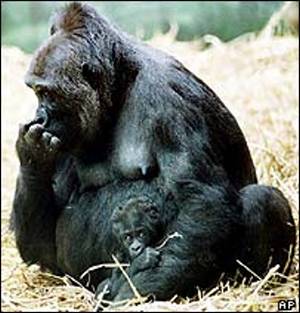
Gorillas are just another victim of the country's civil war
Coltan is used to make pinhead capacitors, which regulate voltage and store energy in mobile phones.
The spread of mobile phones across the world in recent years has led to a coltan boom in eastern DRC, home to 80% of the world's coltan reserves.
TVE says the price of coltan surged a few years ago from $65 to $600 a kilogram.
The British primatologist Ian Redmond says: "To work in the park, the miners have to pay one spoonful of coltan to the military, and one spoon to the local chief. That means about $15.
"There are about 15,000 people working here, each paying $15 per week to the military who control the region.
"That's something in the region of $1m a month going into the pockets of the militia."
Unwittingly, TVE says, the users of
mobile phones and other devices incorporating
coltan are contributing to the apes' downfall.
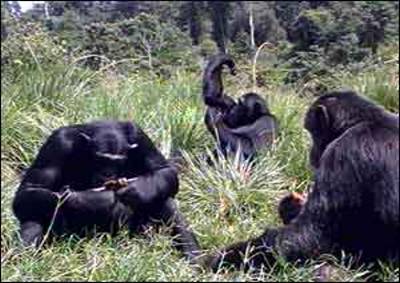
Civil war and mining of the mineral coltan, which is used to make pinhead capacitors in mobile phones and laptops, has brought an influx of people into areas where the apes live. With this often comes a thriving, and on the current evidence unsustainable, bushmeat trade.
"You've got lots of different armed groups going back and forth - often you don't know who is in control of the area," said David Jay, project director at the Born Free Foundation.
A spokeswoman for the International Fund for Animal Welfare (Ifaw) told BBC News Online:
"We and other organisations are
working on the bushmeat issue to encourage those
countries in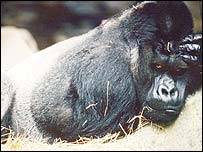 which it is a problem to enforce their own laws
on the killing and selling of great apes.
which it is a problem to enforce their own laws
on the killing and selling of great apes.
"But when the political situation
is out of control it's very hard to see how there's going
to be any priority put on those laws. It's looking very
bleak at the moment."
.................................GOT A MOBILE PHONE HAVE
YOU?
ZNet Commentary
Congo; A Story of “Unimportant
People” April 27, 2005
By Mandisi Majavu
In his book, "King Leopold's Ghost", Adam
Hochschild writes: "At the time of the Congo
controversy a hundred years ago, the idea of full human
rights, political, social, and economic, was a profound
threat to the established order of most countries on
earth. It still is today."
His words hold true today, partly, because the Democratic
Republic of Congo (DRC) contains Africa's largest single
deposit of gold, along with diamonds, coltan, cobalt,
zinc, iron, coal, and uranium. It is reported that Congo
has been a key source of uranium for the West since the
birth of nuclear technology. Congo provided most of the
uranium used to make the bombs dropped on Hiroshima and
Nagasaki in 1945. (1)
These natural resources are particularly plentiful in the
northeastern part of the DRC, where seven militia groups
are still fighting -- two years after the signing of the
"final peace agreement". The fighting is mainly
about the control of the region, for the control of the
region brings with it economic power. The latter is
extraordinarily crucial for any militia group existing in
a country which is in political turmoil, like the DRC.
In June 2004, the investigative NGO, Global Witness,
issued a report that detailed how the DRC's natural
resources fuelled slavery, exploitation, suffering, and a
civil war. They chronicle the DRC history with all its
atrocities from King Leopold?s reign of terror till
today.
King Leopold was a terrorist of the worst kind, a special
breed that stands out from the rest. A shady king like no
other, whose legacy was characterized by forced labour,
vicious whipping, and severed hands. According to
Hochschild's research, king Leopold?s reign of terror was
responsible for about 10 million deaths.
Global Witness described the gradual development of the
1998-2003 civil war, detailing the involvement of
different factions and of neighbouring countries which
relied on the exploitation of the DRC's natural resources
to finance their war expenses.
When the 1998-2003 civil war broke out, Rwanda and Uganda
sent troops to the DRC to back the rebels who were
seeking to oust the late Laurent Kabila (who was the
president at the time). They claimed Laurent Kabila was
backing insurgent who were threatening their national
security. Zimbabwe, Angola and Namibia sent troops to
back Kabila -- splitting the country into rebel and
government-held areas. That war, which is reported to
have killed more than 3 million people in that country,
came to an official end in April 2003.
The main points of the final peace agreement were that
the four-year-old war should halt. That has not happened.
Fighting in the northeastern parts of the DRC continues
unabated. The UN gave the fighters till April 1, 2005, to
hand in their weapons, warning that those who did not
could face prosecution. Militia groups are still
clutching their weapons, more firmly than ever.
Further, the final peace agreement demanded that the
transitional government, headed by Joseph Kabila, was to
pave the way for the transformation process that was to
last two years. It was hoped that at the end of that two
years, the first democratic elections in 40 years would
take place. This month (April) marks the end of that
transformation process. There are reports that elections
in the DRC might be held in June. However, with the
continuing violence in the northeastern part of the
country, it is unlikely. It is amid this violence that we
witnessed two failed coup attempts in the DRC, last year.
According to the UN: since 1999, fighting in the
northeastern district of Ituri has killed more than 50
000 and forced 500 000 to flee their homes. And,
the 16 000 UN peacekeepers in the DRC seem to be
incapable of stopping what some describe as the deadliest
conflict since World War Two. This is the UN's largest
and most expensive mission, but at the same time the most
ineffective and troubled mission the UN has undertaken in
recent times.
And too, in a country that has about 50 million people,
16 000 peacekeepers is not that large. According to
newspaper reports, "Peacekeepers in Ituri
[northeastern Congo], for instance, are responsible for
protecting 6 million people." By contrast, according
to Captain Shebih Hassan, a United Nations peacekeeper
from Pakistan, "Kosovo has 2 million people and 60
000 Nato troops."
Apart from being understaffed, the mission itself has
been a total disaster. There have been reports that the
peacekeepers have failed to defend victims in attacks
despite being authorized to use all necessary means to do
so.
There have been numerous reports that the peacekeepers
are sexually exploiting young girls and women in eastern
Congo. The Sunday Independent, South African weekly
newspaper, reports that: "The UN is investigating
150 instances in which 50 peacekeepers troops or
civilians in the DRC mission are suspected of having
sexually abused or exploited women and girls, some as
young as 12." Furthermore, "the UN is also
investigating reports of rape or sexual assault in the
DRC, including one case in which a French logistics
employee was found with hundred of videotapes that showed
him torturing and sexually abusing naked girls."
Understandably, the anti-war movement has been occupied
only with the imperialist war in Iraq, and is still yet
to include on its agenda civil wars which are the design
of the imperialist mischief-making schemes. Consequently,
we have yet to see urgently needed global solidarity in
Darfur, as well as in the DRC.
It is imperative that the anti-war movement let people
from these regions know that they are not alone. That
they have friends who are in solidarity with their
struggle for freedom, desire for a better life, and hope
for a world where poverty is the thing of the past.
So, I pose the question, what is going to take us to move
from where we are to a position where we will have means
to provide this kind of solidarity?
**********************************************
http://www.zmag.org/sustainers/content/2005-04/27majavu.cfm